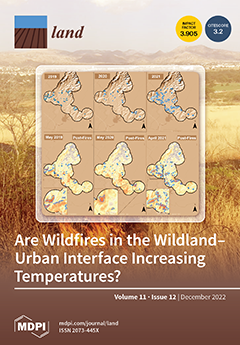Artemisia sieberi Besser occurs in many parts of the Irano-Turanian floristic region, which is mostly distributed throughout the Iranian plateau, especially in Iran. This study aimed to identify the effect of the soil and topography variables on
A. sieberi distribution. We used canopy
[...] Read more.
Artemisia sieberi Besser occurs in many parts of the Irano-Turanian floristic region, which is mostly distributed throughout the Iranian plateau, especially in Iran. This study aimed to identify the effect of the soil and topography variables on
A. sieberi distribution. We used canopy cover data to fit models using generalized additive models (GAMs). The results showed that the response pattern of
A. sieberi along with the gradient of soil clay, soil saturation moisture, soil nitrogen and soil acidity followed the monotonic increase model, and its canopy cover percentage augmented by increasing the values of the factors. Conversely, the
A. sieberi canopy cover percentage decreased by increasing the amount of soil sand, bare soil and the geographic aspect. The
A. sieberi responses are in contrast to the niche theory. The relationship between the species response pattern and the gradients of soil silt, soil salinity, lime percentage, organic carbon, altitude, land slope, litter, gravel percentage, stone percentage, mean annual precipitation and mean annual temperature followed a unimodal model (consistent with the niche theory). The optimal growth limits for these factors were 32%, 1.75 ds/m, 35%, 1.3%, 2000 m, 43%, 10%, 32%, 250 mm and 15 °C, respectively. Our results highlight that environmental factors, such as soil texture, amount of soil lime, mean annual precipitation, altitude and land slope, had quantifiable effects on the performance of
A. sieberi. Our findings could provide useful information for improvement, restoration and conservation programs. However, a further comprehension of the species–environment relationship is needed to predict the effects of climate change on the species habitat.
Full article





